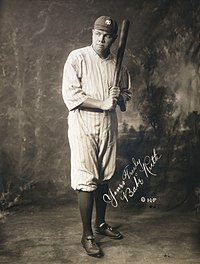
Back Slugging Percentage German Slugging Spanish Moyenne de puissance French Media bombardieri Italian 長打率 Japanese 장타율 Korean Slugging percentage Polish 長打率 Chinese

In baseball statistics, slugging percentage (SLG) is a measure of the batting productivity of a hitter. It is calculated as total bases divided by at-bats, through the following formula, where AB is the number of at-bats for a given player, and 1B, 2B, 3B, and HR are the number of singles, doubles, triples, and home runs, respectively:
Unlike batting average, slugging percentage gives more weight to extra-base hits such as doubles and home runs, relative to singles. Such batters are usually referred to as sluggers. Plate appearances resulting in walks, hit-by-pitches, catcher's interference, and sacrifice bunts or flies are specifically excluded from this calculation, as such an appearance is not counted as an at-bat (these are not factored into batting average either).
The name is a misnomer, as the statistic is not a percentage but an average of how many bases a player achieves per at bat. It is a scale of measure whose computed value is a number from 0 to 4. This might not be readily apparent given that a Major League Baseball player's slugging percentage is almost always less than 1 (it being the case that a majority of at bats result in either 0 or 1 base). The statistic gives a double twice the value of a single, a triple three times the value, and a home run four times.[2] The slugging percentage would have to be divided by 4 to actually be a percentage (of bases achieved per at bat out of total bases possible). As a result, it is occasionally called slugging average, or simply slugging, instead.[3]
A slugging percentage is usually expressed as a decimal to three decimal places, and is generally spoken as if multiplied by 1000. For example, a slugging percentage of .589 would be spoken as "five eighty nine." Slugging percentage can also be applied as an evaluative tool for pitchers. This is not as common, but is referred to as "slugging-percentage against".[4]
- ^ Cite error: The named reference
Careerwas invoked but never defined (see the help page). - ^ Baseball Scorekeeping: A Practical Guide to the Rules, Andres Wirkmaa, Jefferson, North Carolina, London: McFarland & Company, Inc., Publishers, 2003.
- ^ "Slugging Average All Time Leaders on Baseball Almanac".
- ^ "What is a Slugging Percentage". MLB.com.
© MMXXIII Rich X Search. We shall prevail. All rights reserved. Rich X Search
